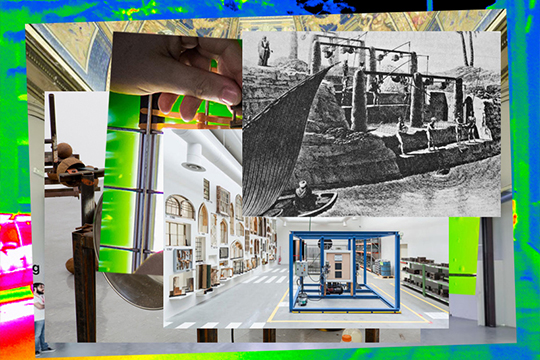Studio 31
Obstinate Persistance
Andre Bonnice

This studio is available to students enrolled in ABPL90142 Studio C, ABPL90143 Studio D, and ABPL90115 Studio E.
Studio Description
“Architecture is a strange mixture of obstinate persistence and constant flux... Some elements have barely changed in the last 3000-5000 years, others were re-invented last week but in architecture the appearance of a new element is rare; most inventions are re-inventions” (Elements of Architecture 2018, 193)
Through the investigative study of lost architectural elements, energy systems and infrastructures and their embedded histories; students will research and develop designs for a series of discrete ‘reinvented’ architectural elements. Windows, doors, stairs, balconies etc. will be repurposed as forms for energy production and waste management.
In the development of new or reinvented elements, students will consider concepts of comfort and discomfort in relation to habitation and our reliance on the ubiquitous systems of energy and resources that are in service of architecture and its occupants. Students will need to reconcile the relationship between these infrastructures and architecture, with consideration to their utility, context and the social and cultural systems that surround them.
The architectural project becomes a complex collage of the archaic and the current, of the standard and the unique through the development of a hybrid ‘office’ building in the CBD.
Studio Outcomes
The first half of semester will focus on research and testing through a series design esquisses presented as standalone speculative prototypes that explore how novel forms of energy production and waste management might influence architecture. Students will develop a taxonomy of discrete ‘re-invented’ elements to be repurposed and adapted for the final project. Each element will be assessed for its spatial and performative qualities alongside its historical contexts.
There will be an attention to design communication through detailed digital modelling, physical prototypes, orthogonal drawings and expressive rendered imaging; by way of supporting a rigorous research and design methodology. In-class tutorials will be provided for modeling, animation, and visualisation techniques.
Studio Leader
Andre Bonnice is a registered architect and director of Simulaa, an emerging architectural practice working across architecture, urbanism, computation, media and environmentalism.
Andre has experience in the design and delivery of small installations, single and multi-residential and public works, in addition to developing larger (public) educational projects.
Alongside practice Andre is engaged in education through his teaching positions at RMIT and previously at Monash University. Andre values the importance of experimentation in the design studio, through an emphasis on speculative propositions, as a way to affect or influence modes of practice and broader critical, social and cultural thinking.
Readings & References
- Gold, B, 2010, ThermoPoetics: Energy in Victorian Literature and Science, The MIT Press, Cambridge
- Koolhass, R & Bloom, I 2018, Elements of Architecture, 1st edn, Taschen, Cologne
- Mattern, S 2017, Code and Clay, Data and Dirt: Five Thousand Years of Urban Media, 1st edn, University of Minnesota Press, Minneapolis
- Mangan, N 2016, Limits to Growth, exhibition publication, 20 July - 17 September, Monash University Museum of Art, Melbourne
- Iturbe, E 2019, ‘Architecture and the Death of Carbon Modernity’, Log, vol. 47, pp. 10-24
- Ghosn, R 2019, ‘Carbon Re-Form’, Log, vol. 47, pp. 106-117
- Vogt, A 2005, ‘Étienne-Louis Boullée’, in P Ursprung (ed.), Herzog & De Meuron: Natural History, 1st edn, Lars Muller Publishers, Baden, pp 173-183
- Morton, T 2018, Dark Ecology, 1st edn, Columbia University Press, New York
- Roche, F & Lavaux, S, DD 05 R&SIE: Corrupted Biotopes, Damdi, Seoul
Schedule Mondays 18:15-21:15 and Thursdays 09:00-12:00